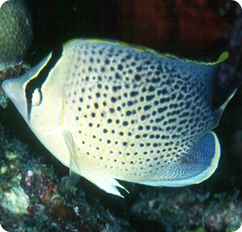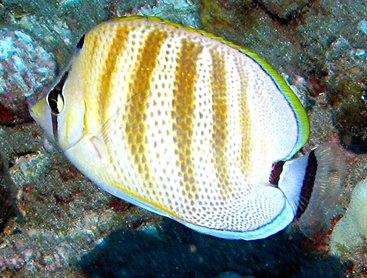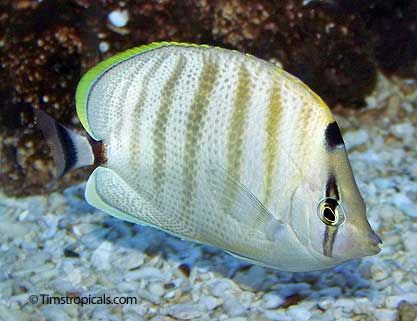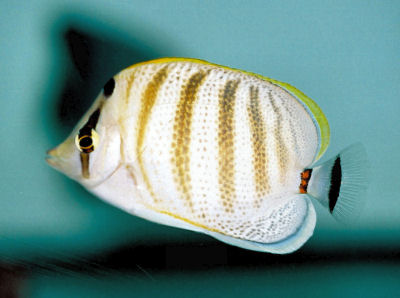
Chaetodon multicinctus
FAMILY
Chaetodontidae
TAXONOMY
Chaetodon multicinctus Garrett, 1863, Hawaiian Islands.
OTHER COMMON NAMES
Hawaiian: Kikakapu.
PHYSICAL CHARACTERISTICS
Deep, compressed body, whitish in color, with four to six narrow
brown or gold-brown bars and many faint olive spots on
both the body and the fins; a gold-brown eye bar on the head,
a black and gold bar on the caudal peduncle, and a solid black
bar on the caudal fin. To 4.5 in (12 cm) total length.
DISTRIBUTION
Limited to the Hawaiian Islands and Johnston Atoll in the
east-central Pacific.
HABITAT
Seaward or lagoon coral reefs, usually with considerable stands
of Porites and Pocillopora corals, between 16 and 98 ft (5–30 m)
in depth.
BEHAVIOR
Forms heterosexual pairs but occasionally occurs in small aggregations.
FEEDING ECOLOGY AND DIET
Omnivorous, its diet consisting of coral polyps, polychaete
worms, small crustaceans, and algae.
REPRODUCTIVE BIOLOGY
Gonochoristic. Paired courtship just before or after sunset
into early evening, with pelagic spawning in the water column.
Spawning pairs are occasionally joined by one or more
intruding males who attempt to spawn with the female. The
intruders may be either rogue males or paired males who
have temporarily abandoned their mates. Courtship occurs
between December and July, but courtship and spawning is
most pronounced between March and July. Eggs and larvae
are pelagic. The eggs are spherical and small (0.023–0.029 in
[0.6–0.75 mm] in diameter). Larvae are around 0.059 in (1.5
mm) in length at hatching and have a large yolk sac. The
mouth is unformed and the eyes are unpigmented. With
growth, the larva develops fused head plates that extend over
the trunk of the body. This is known as the thoichthys stage
of development; it adapts the larva to a long pelagic phase.
Other adaptations include spine formation on the head, dorsal,
and pelvic fins.
CONSERVATION STATUS
Not listed by the IUCN. Coral habitats may be threatened by
coral bleaching, pollution, sedimentation, and other forms of
degradation that may negatively impact populations of this
limited-
DISTRIBUTION
species.
SIGNIFICANCE TO HUMANS
May be collected for the aquarium trade, but this and many
other butterflyfishes generally do poorly in most aquaria.
Photo Gallery of - Pebbled butterflyfish





 Animalia Life
Animalia Life